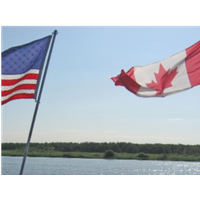
By Kelli Saunders, M.Sc.
International Watershed Coordinator with the Lake of the Woods Water Sustainability Foundation
Several of the articles in this column have focused on water quality issues. Today, I’ll focus on the successful cooperation that has grown over the last decade between governments, our Foundation, the International Joint Commission (IJC) and other partners to work together to understand the issues and find solutions. You’ll get a sense that there is great communication across the border – this is fairly unique. Since the watershed is shared between two provinces, one state and two countries, you can well imagine that there are many players; in fact, there are over 27 agencies with some form of water quality mandate in this watershed. As Watershed Coordinator, my role is to help keep the lines of communication open amongst all these players, help align priorities and ensure partnerships are forged wherever possible. I have to say, the dedication and passion of the people I work with in both countries makes my job very rewarding! More on that in a future article.
Research on Lake of the Woods and its watershed gained momentum in 2008 when the south end of Lake of the Woods in the U.S. was declared “impaired” (due to levels of phosphorus that exceed state standards). With Minnesota leading the way on research to determine where the nutrients are coming from, it was obvious that other partners needed to come on board to help provide information on the rest of the watershed. Since that time, Ontario’s Ministry of Environment, Conservation and Parks, Ministry of Natural Resources and Forestry, the Red Lake Band of Chippewa Indians, Environment and Climate Change Canada and several universities have contributed data to get a more fulsome picture of the nutrient inputs and the processes at work, including climate change. Much of the sharing of data was done because of a very unique cooperative that formed across the border, called the International Multi-Agency Arrangement (or IMA), in 2009. This is an innovative collaborative of resource agencies at all levels of government, the Red Lake Band, our Foundation and the Koochiching Soil and Water Conservation District in Minnesota. The IMA’s purpose was to foster coordination on science and management activities to enhance/restore water quality in the Lake of the Woods watershed. Initially, the focus was on nutrients and algae blooms, erosion on the south shore and providing the science and support for the development of a Lake of the Woods Water Sustainability Plan. This group meets regularly and has expanded its purpose to also include contaminants and aquatic invasive species.
The IJC, formed under the Boundary Waters Treaty of 1909, has been present in this watershed for many decades, but the most recent watershed-wide presence came when they established the International Rainy-Lake of the Woods Watershed Board, with a mandate to monitor ecosystem health and water levels in the waters shared here by Canada and the U.S. The Treaty provides principles for Canada and the U.S. to follow in using the waters they share. For example, both countries must agree to any project that would change the natural levels or flows of boundary waters. Far ahead of its time, the Treaty also states that waters shall not be polluted on either side of the boundary to the injury of health or property on the other side. The principles in the Treaty are as relevant today as they were in 1909 and the ongoing work of the Board helps to fulfill the Treaty's purpose of preventing disputes as well as resolving them. Locally, the IJC Board works with local agencies and the IMA to provide the tools they need to fulfill their mandate of monitoring ecosystem health.
Next week, I’ll tell you about the International Watershed Coordination Program, launched in 2012, that has become the “glue” for all the good work and partnerships around us!This series is provided as part of the International Watershed Coordination Program of the Lake of the Woods Water Sustainability Foundation (www.lowwsf.com).
